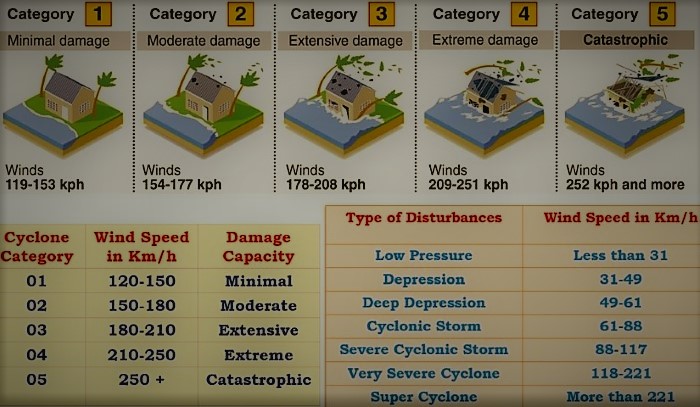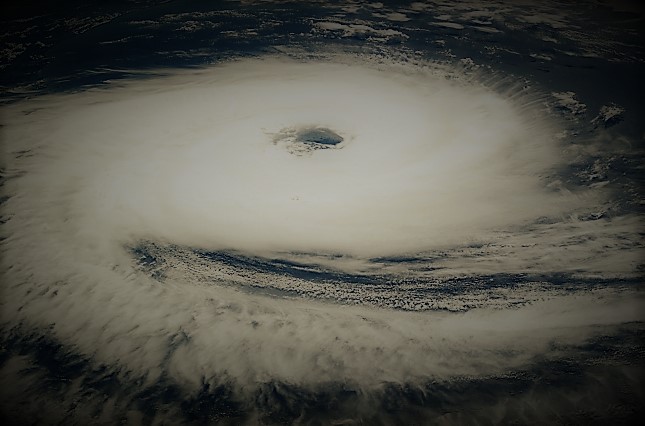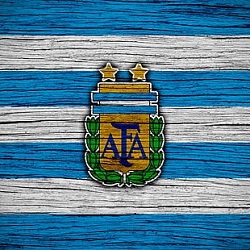THE TROPICAL CYCLONES.
The cyclones originating and traveling through the tropics i.e between Tropic Of Cancer and Tropic Of Capricorn are known as tropical cyclones.These cyclones are thermal in origin and they develop over tropical seas during a particular season.At these locations, due to the Coriolis force that is generated by the rotation motion of the earth.Because this force the local convection currents develops the whirling motion.The ideal conditions for birth and development of the tropical cyclones are-
- QUIET AIR.
- HIGH TEMPERATURE.
- HIGHLY SATURATED ATMOSPHERE.
TYPES OF TROPICAL CYCLONES.
The World Meterological Organisation has classified the tropical cyclones into three.These are-
- Tropical Depression-The low pressure system that is enclosed within few isobars.The wind speed is below 17m/sec.
- Tropical Storms-Isobars closed with air circulation of 17-32m/sec.
- Tropical Cyclones-Due to intense heating,the vertical air currents are formed in the tropics.It has a small diameter,approximately circular in shape
Different Names Of Tropical Cyclones And Their Regions.
| CYCLONE. | REGION. |
| HURRICANES. | WEST INDIES AND FLORIDA. |
| TYPHOONS. | JAPAN,SOUTH AND CHINA SEA. |
| CYCLONES | INDIAN OCEAN. |
| TAIFU. | JAPAN |
| WILLY-WILLY. | AUSTRALIA. |
| BAGUIO. | PHILIPPINES. |
CONDITIONS FOR THE FORMATION OF TROPICAL CYCLONE.

- GOOD SOURCE OF LATENT HEAT-The temperature above 27° C ensures sufficient evaporation.The moisture provides it sufficient latent heat.
- Depth Of Warm Water- 27° C warm water must be up to depth of 60-70 meters.In absence of it,deep convection will bring cooler water to the surface.This will interrupt the supply of heat.
- PRE-EXISTING LOW-LEVEL DISTURBANCES-The low-level disturbances develops into a tropical cyclone of violent intensity.
- UPPER ATMOSPHERIC DISTURBANCES-The remnants of upper troposhperic cyclone from the Westerlies moves into the tropical regions.The divergence prevails on the eastern side of old abandoned troughs, a rising motion occurs.The thunderstorms are formed.These old troughs have cold cores. The lapse in the temperature increases the activity of the thunderstorm.
- CORIOLIS FORCE (f)-Due to rotation of the earth wind do not cross the isobars but are deflected from their original path.This is called as Coriolis Effect or Coriolis Force.The Coriolis Force is zero at the equator but increases with latitudes.The force at 5° latitude is significant enough to create a cyclonic storm. The 65%of the cyclonic activity is found between 10° and 20° latitude.
- WIND SHEAR-The vertical wind shear between the upper and lower layers of the troposphere should be at minimum level.The tropical cyclones develop when the wind is uniform.Because of weak vertical shear, cyclone formation is limited to the latitude equatorward of the sub tropical jet streams.
- UPPER TROPOSPHERIC DIVERGENCE- A well developed divergence in the upper layers of the atmosphere is necessary so that the rising air currents within the cyclone continue to be pumped out and a low pressure is maintained at the centre.
- HIGH HUMIDITY LEVEL- The humidity level is between 50-60%. This will allow cumulonimbus convection.
STRUCTURE OF THE TROPICAL CYCLONE.

Tropical cyclone is radically symmetrical,violent winds spiral inwards,anti clock wise in northern hemisphere and clock wise in southern hemisphere.From eye in the center to the outside of the storm,the cyclone is divided into six regions.
- The Eye-The eye is at the center of the cyclone,it is circular and has a diameter between 5-50 km.The important features are clear sky, low pressure and high temperature.The air at the out \ward edge is dragged upward and outward by surrounding air accentuating low pressure and induces air from above to sink into the wall. The air with in the eye comes from two sources-Mixing and subsidence from the surrounding cloud wall and subsidence from troposphere through the break in tropopause.
- Eye Wall-These are the walls of cumulonimbus clouds. circular region 10-20 km wide.The eye wall is characterised by the strongest winds within the eye wall, consists of continuous rings of intense thunderstorm involving explosive cumulonimbus growth with violent vertical motion , intense rainfall.
- Spiral Bands-These bands gives the cyclone a galaxy type appearance sometimes hundreds of kilometers long, few kilometers wide and the distance within is 50-80 km near the edge decreasing towards the eye.Also called as rainbands or feeder bands. It is characterised by many individual thunderstorms which produce heavy rainfall spiralling towards center, intense precipation and wind, thebands rotate with the storm.
- Annular Zone-It is characterised by suppressed cloudlines, high temperature, low humidity because of subsidence of air from aloft at the outer limits of the cyclone.
- Outer Convective Bands-It occurs at the edge of the main cloudmass and consist of an outer fringe of deep convective cloud produce as a result of instability.
- Limited Cloud Cover And Limited Depth of Convection-Within the trade wind regime.Subsidence from the outflow at the tropical cyclone causes lowering of Trade Wind Inversion.
DESTRUCTION CAUSED BY THE TROPICAL CYCLONE.

The tropical cyclones are the most deadly and destructive type of severe weather event on our planet. The damage that tropical cyclones inflict is caused by high speed winds, heavy rainfall, storm surge and tornadoes. The wind speed in the tropical cyclones is usually directly related to the atmospheric pressure.The lower the pressure the faster the winds blow.The wind speed also varies within the storm. High winds inflict damage by blowing down the objects, creating choppy waves and high seas, and inundating coastal areas with seawater. The rainfall within the tropical cyclones can often exceeds 60 cm i.e 24 inches in a 24 hour period.If this rainfall occurs on land flooding occurs.








Brian Donegan. “The Most Active Month for Hurricanes Begins This Weekend; Is the Tropical Atlantic About to Wake Up?”.